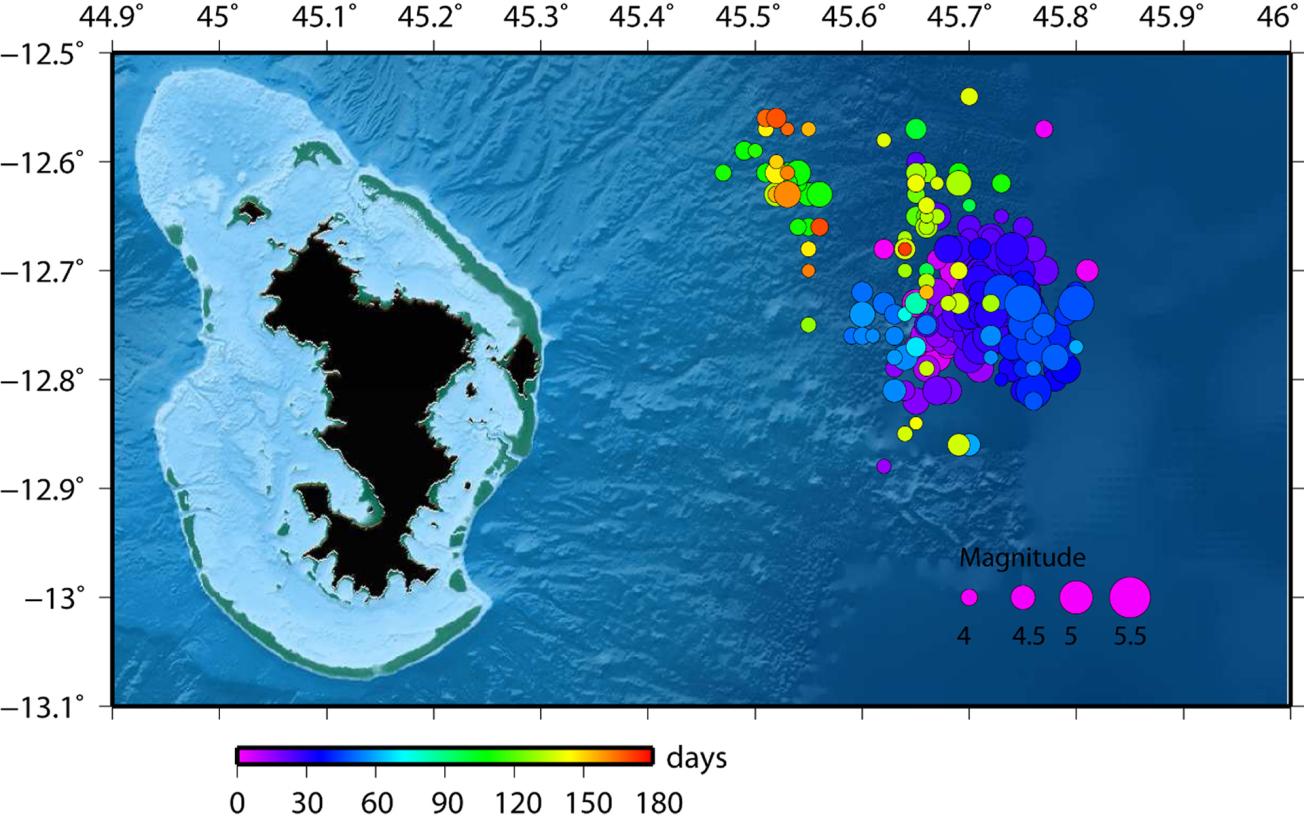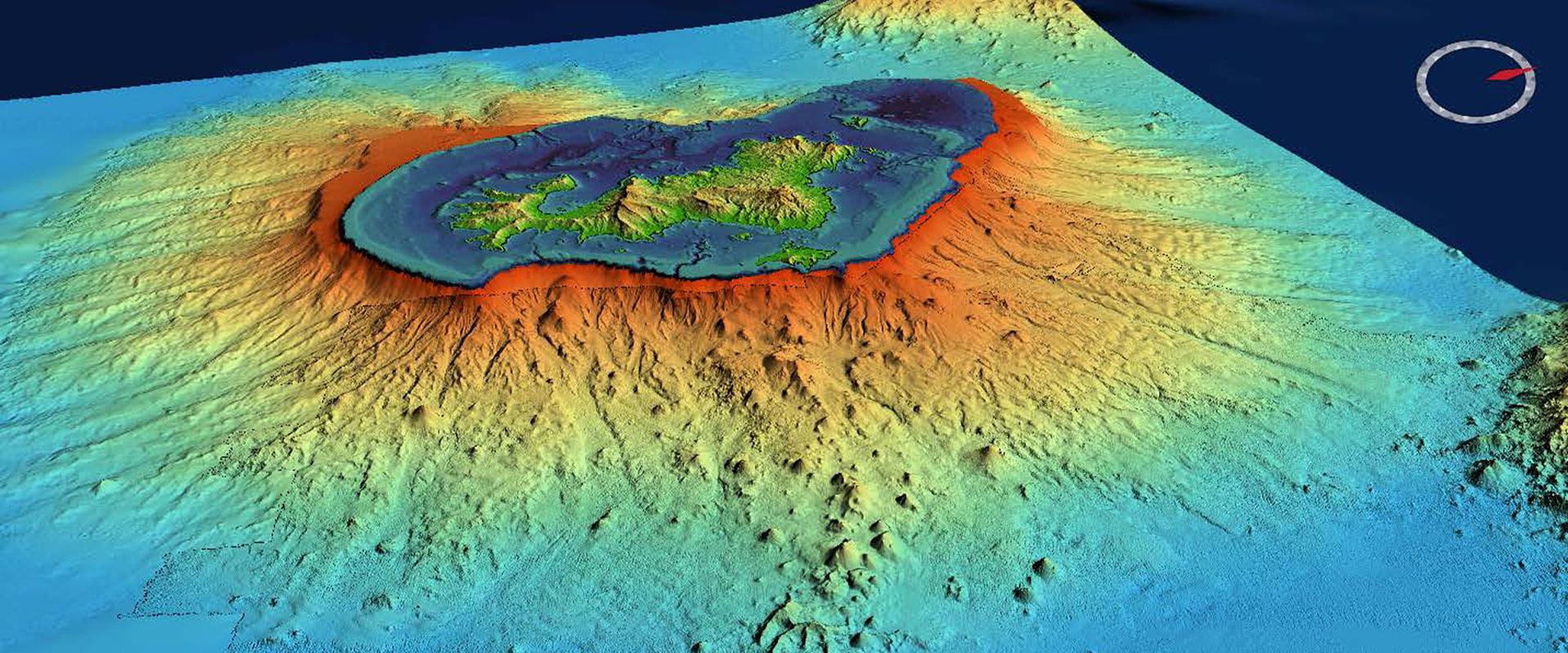
Location of earthquakes above magnitude 3.8 since the beginning of the current episode up to 29 October.
© BRGM / Bathymetry HOMONIM, SHOM et GEBCO (2014)
What is an "earthquake swarm"?
The current seismic activity in Mayotte corresponds to what is known as an "earthquake swarm", which is an episode of multiple seismic events occurring in a particular zone over several days or weeks. This is a very different type of episode to the phenomenon described as a "main shock, followed by smaller after-shocks", as previously experienced in Mayotte.
The first earthquake was detected on Thursday 10 May at around 8:14 local time. On Tuesday 15 May, the highest magnitude quake ever recorded in the Comoros was then detected at 18:48 local time. This reached a magnitude of 5.8 and was felt across the entire island of Mayotte and on other Comoros islands.
The seismic sequence has continued since, but the observed magnitudes have lessened since July 2018. This indicates that the seismic energy released has weakened since the start of the crisis, although some earthquakes are still being felt by the population.
Epicentre about 50km offshore from Mayotte
The epicentre of the current earth earthquakes is located at sea within a zone about 20 km in diameter some 50 km to the east of Mamoudzou. They are not causing any major damage and, although they are occurring offshore, they are too weak to generate tsunamis. Given their distance from Mayotte, only seismic events above magnitude 4 have been felt by the population (the magnitude represents the energy wave released by a seismic source during an earthquake).
Others are likely to be felt by Mayotte's population. Strictly speaking, and given the limited knowledge available for the region, seismic events of greater magnitude than those already observed cannot be excluded.
The stations run by international seismic monitoring networks are distant from the zone of occurrence and only detect earthquakes of relatively high magnitude. Other seismic events are detected by the BRGM's three seismic stations on Mayotte, which also add more detail to the information from the international network (location, magnitude).
The causes of the phenomenon are becoming clearer
The appearance of this earthquake swarm in May 2018 took scientists by surprise. Geological knowledge of the swarm zone is limited, but a clearer understanding of the phenomenon is emerging as observations continue. Different hypotheses as to their causes have been investigated.
In addition to the seismic measurements used to track how this swarm is evolving, new data were analysed in October and November 2018, especially those on deformation of the island's surface (GPS measurements by the IGN). The team working at the Geology Laboratory of the Ecole Normale Supérieure in Paris has shown that the current phase in the swarm is accounted for by a volcanic component.
In parallel, on 11 November 2018, an atypical very low frequency signal was detected by the international networks. The signal is also visible at the Chiconi seismic station. Signals of this type are characteristic of volcanic phenomena.
These observations therefore back up the hypothesis of a combination of tectonic and volcanic effects accounting for a geological phenomenon involving a seismic sequence and a volcanic phenomenon. This hypothesis will need to be confirmed by future scientific studies.
New observation facilities in the pipeline
In the last few months, the scientific community has joined forces to understand the phenomenon and provide answers to the questions it is raising. Possibilities are being investigated for the deployment of new instruments on land and at sea to improve earthquake detection and location.
An oceanographic campaign involving numerous scientific institutes (BRGM, Strasbourg and Paris Institutes of Earth Physics, Paris Sorbonne, Ecole normale supérieure de Paris, Ifremer) has also been applied for, to explore both the swarm zone and the regional context and to produce more data to better understand the causes of the phenomenon.
Moderate seismic activity in Mayotte
The current episode is in line with the moderate seismic activity known to occur in the Mozambique Channel. Seismic activity is relatively diffuse along the 500km length of the Comoro archipelago and occurs in a tectonic and volcanic context. Earthquakes regularly occur and earthquakes close to magnitude 5 are quite frequent across the zone as a whole.
Seismicity in the immediate vicinity of Mayotte is less well known, but earthquakes causing damage have occurred in the past, for example on 1 December 1993 (magnitude 5.2). However, no destructive earthquakes of magnitude 6 or more have yet been recorded near Mayotte.








The earlier seismic events are shown in mauve and blue; more recent events are in orange and red. The cloud of dots around 45.5°E began to appear in late August 2018. While the current seismic network accurately detects seismic events above magnitude 3.5, it cannot produce the precise location of these events. The degree of uncertainty is 10-15 km for an earthquake swarm barely 20 km in extent. Consequently, the location uncertainties are too high to indicate the main direction of the seismic activity. The depth of seismic activity is not determined by the observation network as currently configured.